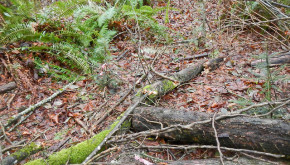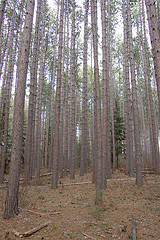
by Deborah Page-Dumroese
Demand for forest biomass for bioenergy production is expected to increase during the next century. The search for alternative energy sources, including forest bioenergy, increases pressure on the productive capacity of forest lands. Soils must be able to simultaneously support current timber harvesting methods and provide long-term forest growth.
Bioenergy harvest operations are becoming more prevalent because of the large amount of biomass accumulating from previously reduced forest harvesting and fire suppression. Logging or thinning operations generate a considerable amount of residue which had previously been left on-site, burned in slash piles, or removed as hog fuel. Consequently, bioenergy harvesting may impact soil physical, chemical, and biological environment to a greater degree than traditional timber harvesting. Soil impacts are dependent on the amount of organic matter and woody residues on the soil surface, soil texture (e.g.,clay, silt, sand), rock content, and soil depth. For example, harvesting often compacts clay and silt soils more than sandy soils. However, soils that compact the easiest are often less susceptible to reductions in nutrients from biomass harvesting (e.g., finer textured soils typically have higher plant essential nutrients). Biomass removal mitigation strategies must reflect site conditions to maintain the health and fertility of the soil resource. Thus the question: “Some woody residues must be left behind, but how much and what kind”?
Fine woody residues. Fine woody residues are less than three inches in diameter. Ecologically, this material adds soil cover and can reduce soil erosion, moderate soil temperatures, and on some sites may increase soil nutrients. Published data indicates that intensive harvesting and removal of small diameter residues does not universally reduce site productivity. However, removal of all fine woody residues following repeated harvests can cause substantial growth declines on coarse textured soils with low soil organic matter.
Coarse woody residues. Coarse woody residue is material greater than seven inches in diameter and is usually laying on the soil surface. Coarse wood can be added to a site during logging or when a snag falls. Ecologically, coarse woody residues function as habitat for a variety of organisms, including fungi, mosses, liverworts, insects, amphibians, reptiles, small mammals and regenerating plants. On any given site, coarse wood is naturally regulated by local climatic regimes, which determine decomposition rates. As woody debris decays, it eventually forms soil wood (covered by mineral soil and forest floor material), where it helps to improve nutrient cycling and increases water holding capacity. This slow incorporation of woody material into the mineral soil improves soil properties over the long-term and influences tree growth over time. Coarse wood also affects ponding, sediment trapping and aeration in streams.
How much woody residues should I leave?It is relatively easy to determine how much coarse and fine woody residues are present on the soil surface before harvesting. One good rule of thumb is to retain the same amount of coarse and fine woody residue that is on-site pre-harvest. More specifically, research suggests that retaining 30 percent of fine woody residues on slopes less than 30 percent and 50 percent retention on steep slopes is a reasonable and conservative estimate.
Best Management Practices. Opportunities for Best Management Practices (BMPs) are mostly common sense: limit logging when the soil is wet, match equipment to the site, use winter logging to minimize ground disturbances, leave the stumps in place, and don’t create large slash piles for burning. Long-term research indicates that the key to sustainable forestry is to keep the surface organic horizons (fresh and decaying organic matter) intact so you can maintain nutrient cycling and moisture retention, and prevent erosion.
On many sites before harvest operations begin, you can develop your own BMPs based on soil nutrient levels, depth of the mineral soil, amount of rocks, and local climatic regimes (rainy, cool, hot, dry, etc.). Knowing if your soil is limited in some nutrients can help you determine how much fine or coarse woody residue will benefit your land. Geospatial information on the physical and chemical properties of your soil type(s) is available from the Natural Resource Conservation Service (NRCS) Web Soil Survey.
Additional Resources:
University of California Davis Soil application
This is a condensed version of a soil and biomass harvesting article. Go to full article.
Deborah Page-Dumroese is a research soil scientist for the Rocky Mountain Research Station in Moscow, Idaho. She can be reached at 208-883-2339 or [email protected].


